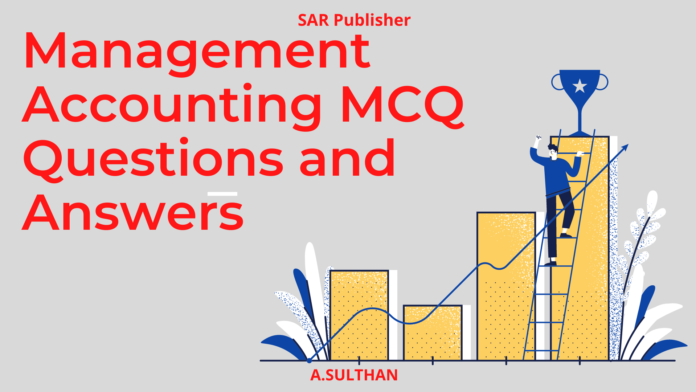Management Accounting MCQ Questions and Answers Part – 1
Management Accounting MCQ Questions and Answers Part – 2
Management Accounting MCQ Questions and Answers Part – 3
1. The ratios which reflect managerial efficiency in handling the assets is__________.
A. turnover ratios.
B. profitability atios.
C. short term solvency ratio.
D. long term solvency ratio.
ANSWER: A
2. The ratios which reveal the final result of the managerial policies and performance is __________.
A. turnover ratios.
B. profitability ratios.
C. short term solvency ratio.
D. long term solvency ratio.
ANSWER: B
3. Return on investment is a ________.
A. turnover ratios.
B. short term solvency ratio.
C. profitability ratios.
D. long term solvency ratio.
ANSWER: C
4. Stock turnover ratio is a _____________.
A. activity ratio.
B. profitability ratio.
C. short term solvency ratio.
D. long term solvency ratio.
ANSWER: A
5. The ratio which measures the profit in relation to capital employed is known as __________.
A. return on investment.
B. gross profit ratio.
C. operating ratio.
D. operating profit ratio.
ANSWER: A
6. Prepaid expenses is an example of _________.
A. fixed assets.
B. current assets.
C. fictitious assets.
D. current liabilities.
ANSWER: B
7. Turnover ratio is also known as ___________.
A. activity ratios.
B. solvency ratios.
C. liquidity ratios.
D. profitability ratios.
ANSWER: A
8. Which ratio is calculated to ascertain the efficiency of inventory management?
A. Stock velocity ratio.
B. Debtors velocity ratio.
C. Creditors velocity ratio.
D. Working capital turnover ratio.
ANSWER: A
9. P/V ratio means __________.
A. Contribution/Sales
B. Sales/Contribution
C. Fixed cost/Sales
D. Cost of goods sold/contribution
ANSWER: A
10. Which ratio measures the number of times the receivables are rotated in a year in terms of sales?
A. Stock turnover ratio.
B. Debtors turnover ratio.
C. Creditors velocity ratio.
D. Working capital turnover ratio.
ANSWER: B
11. The ratio which indicates the number of times the payables are rotated in a year is ____________.
A. stock turnover ratio.
B. stock turnover ratio.
C. creditors velocity ratio.
D. working capital turnover ratio.
ANSWER: C
12. Current assets – current liabilities =_______.
A. fixed capital.
B. working capital.
C. opening capital.
D. closing capital.
ANSWER: B
13. The ratio of current assets to current liabilities is called_______.
A. liquid ratio.
B. acid test ratio.
C. current ratio.
D. cash position ratio.
ANSWER: C
14. Standard current ratio is____________.
A. 1:1.
B. 2:1.
C. 3:1.
D. 4:1.
ANSWER: B
15. Current assets – (stock + prepaid expenses) =______________.
A. current assets.
B. fixed assets.
C. liquid assets.
D. fictitious assets.
ANSWER: C
16. An ideal liquid ratio is_______.
A. 0.25: 1.
B. 0.50: 1.
C. 0.75: 1.
D. 1: 1.
ANSWER: D
17. An ideal debt-equity ratio is________.
A. 1
B. 2
C. 3
D. 4
ANSWER: A
18. Capital gearing ratio is also known as___________.
A. leverage ratio.
B. fixed assets turnover ratio.
C. proprietary ratio.
D. debt-equity ratio.
ANSWER: A
19. Shareholders funds + Long-term loans =_____________.
A. current assets.
B. current liabilities.
C. fixed assets.
D. capital employed.
ANSWER: D
20. Net capital employed is equal to _________.
A. total assets minus total liabilities.
B. fixed assets plus net-working capital.
C. total assets minus long-term liabilities.
D. total assets.
ANSWER: B
21. All those assets which are converted into cash in the normal course of business within one year are known as _________.
A. current assets.
B. fixed assets.
C. fictitious assets.
D. wasting assets.
ANSWER: A
22. All those liabilities which are payable in cash in the normal course of business within a period of one year
are called _________.
A. long term liabilities.
B. overdraft.
C. short term loans.
D. current liabilities.
ANSWER: D
23. Any transaction between a current item and another current item does not affect.
A. profit.
B. funds.
C. working capital.
D. capital.
ANSWER: B
24. ‘Principle’ for preparation of working capital statement- Increase in current asset _______.
A. increases working capital.
B. decreases working capital.
C. decrease fixed capital.
D. increase fixed capital.
ANSWER: A
25. ‘Principle’ for preparation of working capital statement – Decrease in current asset ______________.
A. increases working capital.
B. decreases working capital.
C. decrease fixed capital.
D. increase fixed capital.
ANSWER: B
26. ‘Principle’ for preparation of working capital statement -Decrease in current liability _____________.
A. increases working capital.
B. decreases working capital.
C. decrease fixed capital.
D. increase fixed capital.
ANSWER: A
27. ‘Principle’ for preparation of working capital statement -Increase in current liability ___________.
A. increases working capital.
B. decreases working capital.
C. decrease fixed capital.
D. increase fixed capital.
ANSWER: B
28. Depreciation on fixed assets is _________.
A. non operating income.
B. operating expense.
C. operating income.
D. non operating expense.
ANSWER: D
29. Provision for Income tax is ____________.
A. non operating income.
B. operating expense.
C. operating income.
D. appropriation of profits.
ANSWER: D
30. Profit on sale of fixed assets is __________.
A. non-trading income.
B. operating income.
C. non-trading gains.
D. long term gain.
ANSWER: C
31. In fund flow statement, issue of shares is ________.
A. sources of funds.
B. applications of funds.
C. sources of cash.
D. applications of cash.
ANSWER: A
32. In funds flow statement, sale of fixed assets is ___________.
A. applications of funds.
B. sources of cash.
C. applications of cash.
D. sources of funds.
ANSWER: D
33. In funds flow statement, funds from operations is _________.
A. applications of funds.
B. sources of cash.
C. applications of cash.
D. sources of funds.
ANSWER: D
34. In funds flow statement, increase in working capital is ________.
A. applications of funds.
B. sources of cash.
C. applications of cash.
D. sources of funds.
ANSWER: A
35. In funds flow statement, decrease in working capital is _________.
A. applications of funds.
B. sources of cash.
C. applications of cash.
D. sources of funds.
ANSWER: D
36. In funds flow statement, repayment of long-term loans is ________.
A. applications of funds.
B. sources of cash.
C. applications of cash.
D. sources of funds.
ANSWER: A
37. In funds flow statement, purchase of fixed assets is _________.
A. sources of cash.
B. applications of funds.
C. applications of cash.
D. sources of funds.
ANSWER: B
38. A cash flow statement is a statement which portrays the changes in the cash position between _______.
A. two accounting periods.
B. three accounting periods.
C. four accounting periods.
D. five accounting periods.
ANSWER: A
39. The term ‘cash’ in the context of cash flow analysis includes the ‘cash balance’ and the __________.
A. working capital.
B. bank balance.
C. capital.
D. fixed assets
ANSWER: B
40. Cash flow analysis is based on the ______.
A. capital.
B. fixed assets.
C. cash concept of funds.
D. working capital.
ANSWER: C
41. For the calculation of trend percentage which year is considered 100 percent?
A. first year
B. second year
C. third year
D. last year
ANSWER: A
42. Management accounting information is used by _______.
A. management
B. banks
C. creditors
D. government
ANSWER: A
43. Financial statements are classified into _____ statements.
A. four
B. three
C. two
D. five
ANSWER: A
44. Which one of the following is not a management accounting tool?
A. Standard costing
B. Marginal costing
C. budgeting
D. process costing
ANSWER: D
45. Which one of the following is not mandatory according to the laws?
A. Financial accounting
B. cost accounting
C. Management accounting
D. none of the above
ANSWER: C
46. If working capital is Rs. 1,00,000 and current ratio is 2:1, then the amount of current asset is _________.
A. Rs.1,00,000
B. Rs. 2,00,000
C. Rs. 1,50,0000
D. Rs. 2,50,000
ANSWER: B
47. Types of financial analysis are ____.
A. three
B. four
C. five
D. two
ANSWER: B
48. Which one of the following is not the determinant of the working capital?
A. size of the firm
B. operating cycle
C. terms of credit
D. competitors
ANSWER: D
49. Permanent working capital ___
A. will vary at all times
B. will vary with volumes
C. fixed at all times
D. fluctuates according to the season
ANSWER: C
50. Which one of the following is correct?
A. Cost of goods sold=sales -gross profit
B. cost of goods sold= op. stock- purchases + clo. stock
C. cost of goods sold= op. stock+ purchases + clo. stock
D. cost of goods sold= op. stock- purchases – clo. stock
ANSWER: A


